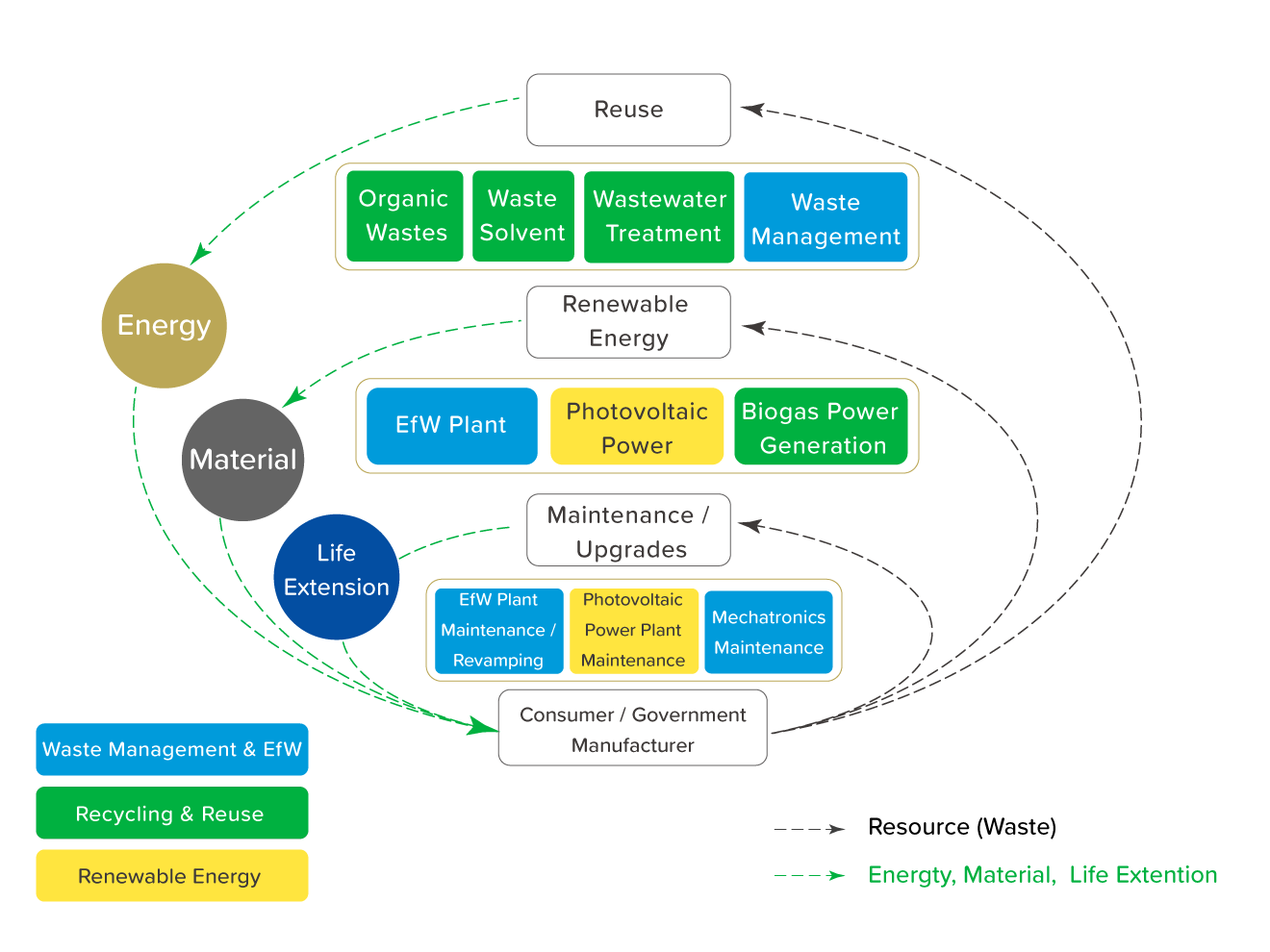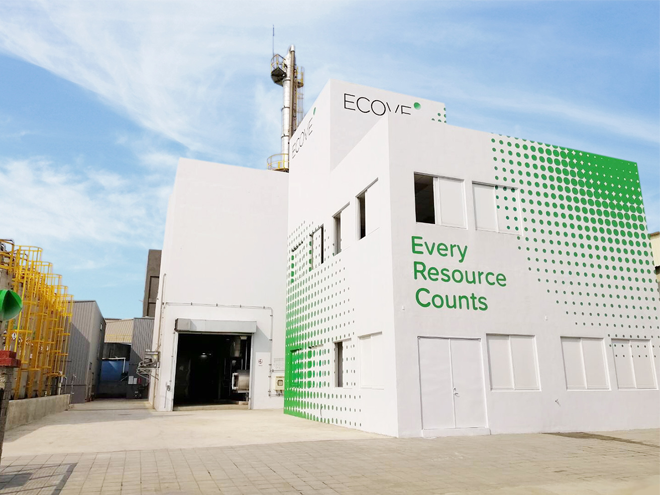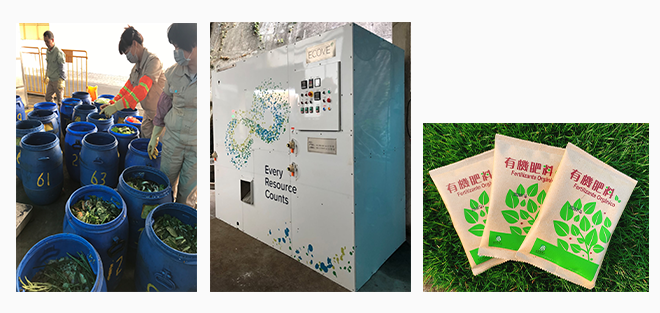Technology
技術分享
Trends and Visions in Recycling and Reusing Technology
— Cheng-Lung Su, President, ECOVE Solvent Recycling Corporation, Group Resource Cycling Business
Due to rapid exhaustion of resources caused by mass consumption and waste, countries across the globe have doubled down their efforts on promoting circular economies. For example, in 2018 the European Parliament passed the Circular Economy Action Plan, aiming to recycle 55%, 60%, and 65% of municipal waste by 2025, 2030, and 2035, respectively. As a global corporate citizen, CTCI cares deeply about global resources and environmental issues. That is why our corporate operations are closely linked to the UN’s sustainable development goals (SDGs), and we put a lot of effort in assuming our corporate social responsibilities. In particular, CTCI Group Resource Cycling Business, which ECOVE Solvent Recycling Corporation as a subsidiary belongs to, is always closely following circular economy trends, as indicated by the fact that all of CTCI Group Resource Cycling Business’ subsidiaries are deeply involved in either waste management and incineration, recycling and reuse, or renewable energy domestically and overseas. To turn waste into resources, we use smart and big data management as well as adopt integrated technologies. It allows us to optimize resource cycling efficiency and help create an innovative circular economy business model. Figure 1 illustrates some specific contributions we have made so far towards global sustainable development. ● Maintenance/renewal: Extend the service life of old equipment through maintenance and renewal, which is the most basic form of resource cycling. This reduces energy consumption and environmental pollution. ● Renewable energy: Reclaim heat from burning waste at incineration plants to generate power, and convert sunlight into electricity. They can boost energy cycling and reduce pollution caused by fossil fuel power generation. ● Reuse: There are various types of wastes that are traditionally considered as useless, such as waste solvents, kitchen waste, and wastewater. Now we are giving them a new life through innovative technologies, so that they return once more to the market as useful resources, thus completing the reuse cycle.

Figure 1. A circular economy business model of CTCI Group Resource Cycling Business.
Giving Waste Solvents a Chance of Rebirth in the Supply Chain Market by Purifying Them
As technology progresses, the scope of circular economy also expands and is no longer confined to traditional waste recycling and trash processing. For example, Taiwan is the world’s top producer of wafers in terms of production value. Yet wafer fabrication and packaging processes generate large quantities of waste liquids, such as isopropanol. In the past, waste liquids were mostly incinerated, which is actually a waste of resources. Thanks to integrated expertise and technologies, CTCI Group Resource Cycling Business now comes to the fore. In 2018, ECOVE Solvent Recycling Corporation (Figure 2) was founded to work with high-tech industries in waste solvent recycling projects. It uses different distillation technologies (e.g., distillation, rectification, osmosis, fractional distillation) to improve integration performance, and select equipment that are optimal for both the environment and effectiveness based on criteria such as energy consumption, material consumption, environmental impact, and overall effectiveness. A prime example is the pervaporation film pore design. By successfully making the pores smaller than the diameters of most organic solvent molecules, ECOVE Solvent Recycling Corporation successfully achieves at least 99% recycling rate for specific components without any addition of other materials. The result is zero waste and a complete cycling, granting recycled waste solvents a “second life” in the supply chain market for further reuse, thereby reducing the consumption of fossil fuel resources.

Figure 2. ECOVE Solvent Recycling Corporation, a subsidiary of CTCI Group Resource Cycling Business, is a service provider in waste solvent reuse.
Ensuring Sustainability of the Land by Turning Kitchen Waste into Organic Compost
Another example of resource recycling and reuse concerns kitchen waste, something that is closely related to our daily lives. Until recently, there has not been a comprehensive and sound comprehensive recycling and reuse system in place for kitchen waste handling in Taiwan. But since kitchen waste mainly comprises organic materials, it is actually a resource that can be reused after being recycled. As a true believer in the circular economy and with aims to boost resource cycling efficiency, ECOVE Waste Management Corporation, another subsidiary of CTCI, competently helps Macanese authorities handle kitchen waste issues through its long-time expertise and technologies in waste recycling and management. ECOVE Waste Management Corporation currently already has sufficient technology to convert kitchen waste into resources, meaning that it is capable of using new technologies to turn kitchen waste that was originally supposed to be incinerated into plant fertilizers. This effectively allows organic waste to return to the land (Figure 3), thus completing the organic cycle and realizing circular economy.

Figure 3. ECOVE Waste Management Corporation, a subsidiary of CTCI Group Resource Cycling Business, uses new technology to convert Macao’s cooked kitchen waste (left) into organic fertilizer (center) and makes it available to the public after repackaging (right).
Always Seeking to Improve Resource Cycling Efficiency
Countries around the world are now working hard to establish zero waste circular economies. Large international corporations, such as Apple, NIKE, and Dell, have all pledged to recycle and reuse 100% of all their product components in the future and to work towards a zero-waste goal. Looking towards the future, CTCI will continue to enhance the integration of technologies, look for opportunities to increase resource cycling efficiency, and reduce waste. At the same time, CTCI will also keep a sharp eye on market trends and updates to explore new solutions for pressing issues, so that the dream of a “circular economy” and zero waste can come true in Taiwan.
